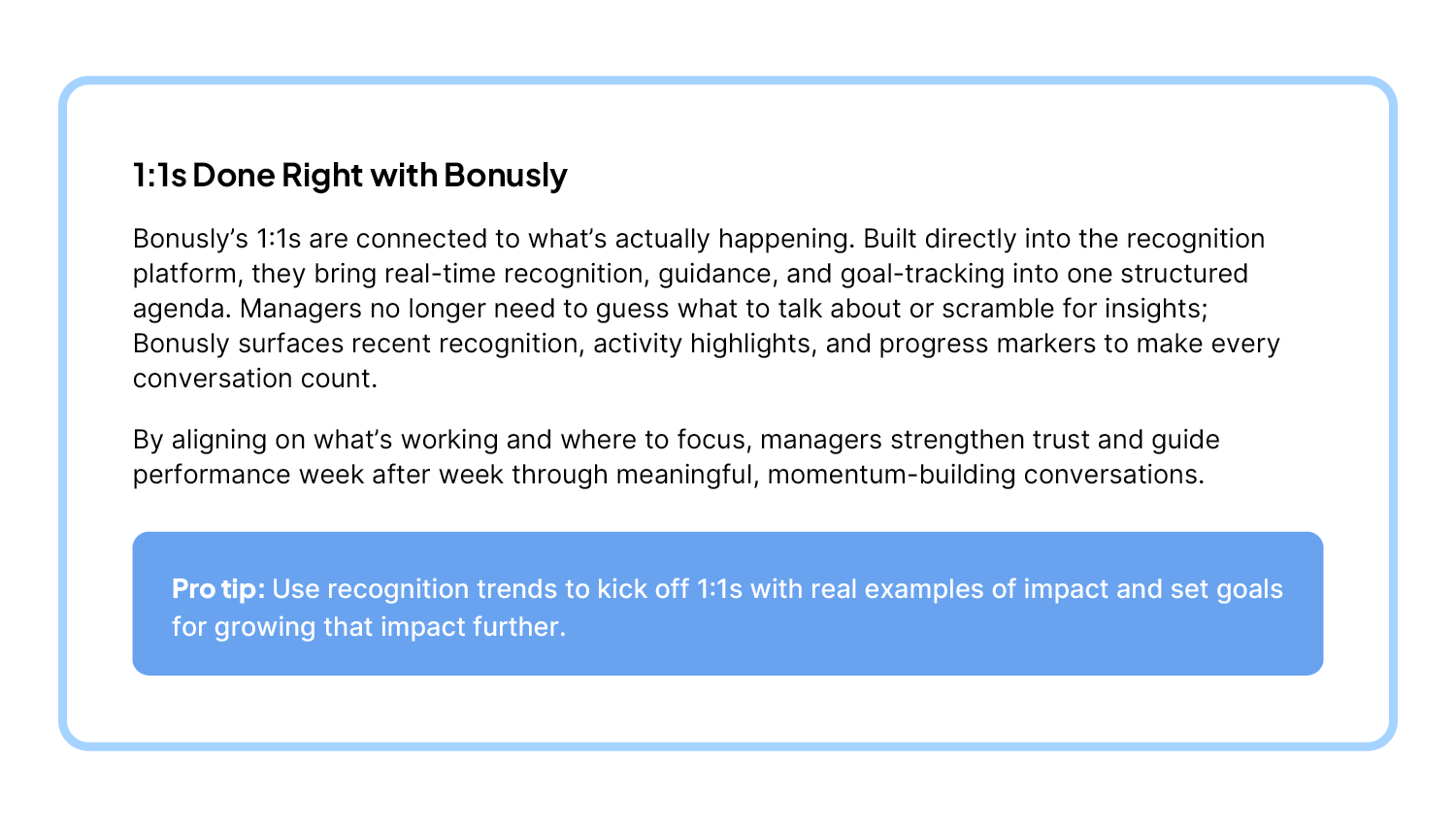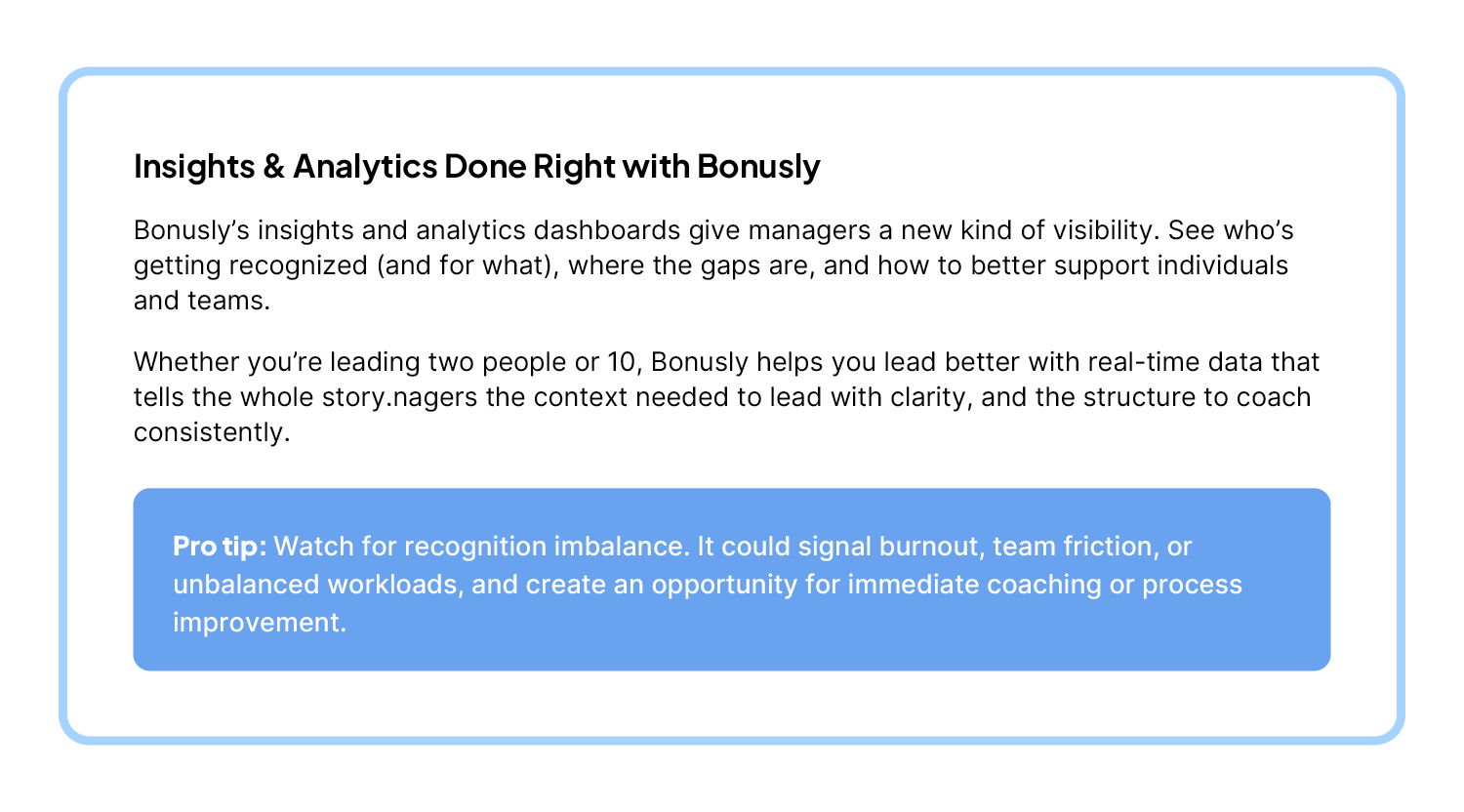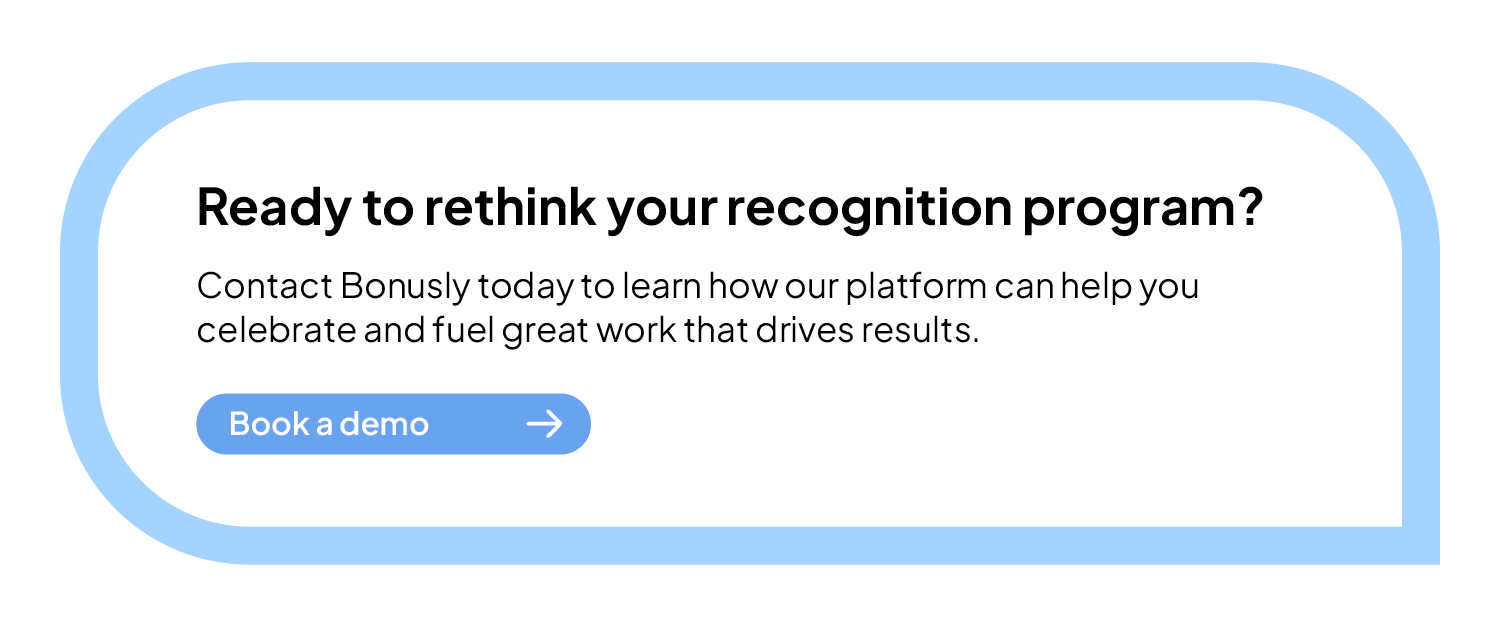Chapter 3: The Manager Playbook
If you want to build a better business, start with your managers.
People leaders are the linchpin of culture and execution. They shape how work gets done, how people feel at work, and whether talent stays or leaves. However, they’re often asked to lead without the necessary tools or insights to do it effectively.
This playbook is built to change that.
Inside, you’ll learn how to equip managers with the visibility and real-time context they need to lead with impact. From better 1:1s and timely feedback to performance recaps and actionable insights, we’ll walk you through how to support, scale, and sustain manager effectiveness.
Whether you're overhauling an outdated system or building from scratch, this guide will help you turn your managers into confident, connected leaders—the true heartbeat of your organization.
Why manager effectiveness matter
Recognition celebrates the work that’s already winning. Effective manager guidance—timely, clear, and supportive direction and feedback—fuels the work that could win next.
When done right, recognition and guidance work together to create clarity and momentum. Employees need to know what they’re doing well and where to grow. It’s not enough to say, “Great job today.” The best managers also show what greatness looks like tomorrow and the quarters to come.
Today’s managers are expected to do it all: coach performance, engage teams, develop skills, spot burnout, retain top talent, and (still hit their goals). But they’re often leading in the dark.
Without clear visibility into day-to-day contributions, managers are left guessing what’s working and who needs support. They’re forced to make decisions based on fragmented systems or lagging metrics. Meanwhile, employees want real-time input.
Managers need tools that give them context in the moment, not after the fact. When they have access to what’s really happening on their teams, they can lead with clarity and confidence.
Management is broken. How do we help managers be the best version of themselves?
Managers are doing what they can. But “checking in” isn’t enough, and performance doesn’t live in a spreadsheet. We believe authentic leadership happens in the moments that matter: when someone steps up, starts to drift, or smashes a goal. Bonusly helps managers see those moments and do something about them.
Meeting employee demand
Employees want feedback, but also want to feel psychologically safe enough to receive it. Managers want to be leaders, but they need better tools. Guidance, recognition, and coaching must happen in the same cadence; when employees know their strengths and how to build on them, growth becomes a shared goal.
The case for richer data
The future of performance management forgoes forms or dashboards for richer, in-the-moment, contextual insights. Bonusly transforms everyday recognition and guidance into a living, breathing picture of what’s working, who’s driving it, and where to focus next. Managers get the visibility they need, and teams get the clarity they deserve.
How to think about ROI
When effective manager guidance is consistent, constructive, and actionable:
- Employees know how to grow
- Managers lead with confidence
- Teams align on goals
- Turnover drops
- Performance rises
Employee Experience
The numbers:
-Managers account for 70% of the variance in employee engagement.
-Trust and inclusion from managers drive higher employee engagement and satisfaction.
What success looks like:
-Regular, relationship-driven 1:1s.
-Winning teams that are aligned
What success sounds like:
"My manager understands and celebrates my strengths, and stretches me enough to feel like I'm actually growing."
Employee Impact
The numbers:
- Effective direct report development boosts performance by 27% and increases goal achievement by 1.5x.
- Great managers lead teams that are up to 35% more productive.
What success looks like:
- Managers have the context to coach effectively.
- Performance is an ongoing process with improvement happening in the moment.
What success sounds like:
"I have the right visibility and context to guide my team to greatness.”
Employee Retention
The numbers:
-Employees who feel their manager supports their development are up to 10x more likely to stay.
-High-turnover organizations report significantly lower feedback and recognition rates.
What success looks like:
-Growth conversations that start early and happen often.
-Recognition that builds ongoing trust and lasting relationships.
What success sounds like:
“I know my work matters and that my manager is supporting all of my wins and growth opportunities.”
Becoming a best-in-class manager
Effective Management Moments
Good
Managers hold occasional 1:1s and rely on annual performance reviews. Feedback is typically one-directional and delayed, with little structure or visibility into day-to-day work. Most coaching happens reactively, if it happens at all.
Better
Managers use a structured agenda for regular 1:1s and give ad hoc guidance as needed. Recognition and feedback are more frequent. Development conversations happen, but rely heavily on manager memory or siloed tools.
Best
Guidance, recognition, coaching, and goal-setting are integrated into the workday. Managers have real-time visibility into contributions, can spot momentum or misalignment early, and use shared tools to support development. Employees feel supported, seen, and inspired to grow.
Launching and building your program
Effective managers lead with intention. Here are the foundational elements every program needs to thrive:
- Give managers visibility and support. Managers are key to successful growth conversations, but need tools and data to lead with clarity. Use analytics and insights to help them coach more effectively.
- Make 1:1s a habit. Create structured, recurring check-ins that go beyond task updates. A best-in-class 1:1 surfaces wins, blockers, guidance, and forward-looking goals.
- Normalize guidance from all directions. Offer multiple, accessible channels for giving and requesting feedback to encourage a culture of openness and continuous learning.
- Tie conversations to recognition. Guidance is most effective when it’s anchored in real contributions. Integrate guidance with recognition moments to make growth feel motivating.
- Provide psychological safety by design. Make feedback less intimidating by making it part of everyday culture. Empower employees to ask for guidance on their terms and ensure it can happen in the tools they already use.
- Build in-progress tracking. Connect manager guidance to goals and revisit progress regularly in 1:1s or recaps. This closes the loop between insight and action, and helps employees see how far they’ve come.
Deep dive: 1:1s
The most effective 1:1s are high-value moments for building trust, aligning on goals, and giving meaningful guidance. When structured well, they become a key driver of engagement and development. Regular check-ins give employees the clarity they need and give managers early signals about performance, well-being, and retention risks.

Deep dive: team guidance
Effective manager guidance is essential for growth, but it truly lands when it’s timely, specific, and safe to give and receive. Employees often want more feedback but hesitate to ask, and managers struggle to make it a habit. The most effective programs make guidance feel normal, not nerve-wracking—embedding it into daily routines, trusted tools, and a culture of mutual support.

Deep dive: performance recaps
Managers are expected to drive performance, but most tools focus on lagging indicators instead of leading conversations. Traditional reviews offer limited insight and come far too late to make an impact. What managers need is a clear, real-time view of how their team is doing and a way to turn that insight into coaching, growth, and alignment.

Deep dive: insights & analytics
Management shouldn’t rely on memory or gut feeling. Managers need visibility into team contributions, recognition patterns, and improvement areas. Richer data helps them confidently lead, catch issues early, and make informed decisions about performance and development. And when feedback data is connected to actual behaviors, it’s far more actionable than a quarterly review.

Other considerations for top programs
Even the best managers can fall short if they don’t have the right support and tools. As you evaluate or optimize your program, here are a few essential, but often overlooked, factors that make a big difference.
- A strategic partner and support team you can count on
Your recognition platform should be a true partner in your culture-building efforts. Bonusly’s Customer Success team is known for being invested in customer outcomes, with dedicated teams that help you launch and scale with confidence. The best support teams proactively guide you through setup and help you unlock more value over time. - Seamless integrations with the tools your team already uses
Recognition and guidance should meet your team where they are, whether that’s Slack, Microsoft Teams, or your HRIS. Bonusly offers best-in-class integrations with all major communication and HR systems, making it easy to recognize teammates in real-time. Integrations boost participation and make recognition feel like a natural part of the workday. - High adoption and visibility across the organization
Recognition and guidance only work if people actually use it. High adoption ensures a steady flow of recognition and provides rich data for understanding how teams work together. Bonusly’s intuitive, mobile-friendly platform drives the highest adoption rate in the industry, giving leaders full visibility into what’s working and who’s making it happen. When recognition is visible and consistent, it shapes culture and drives behavior.
The bigger picture: manager effectiveness as part of an integrated strategy
Recognition and manager guidance are two sides of the same coin. While recognition reinforces what’s working, feedback guides what’s next. They create momentum and continuous improvement.
With Bonusly, managers can seamlessly shift from celebrating wins to coaching growth, without switching tools or waiting for a formal review cycle. The result? Stronger relationships, better performance, and teams that feel seen and supported.
Implementing recognition done right
When recognition and guidance become a shared rhythm, managers lead more effectively, and employees grow with clarity and confidence. The best cultures recognize what’s great and help people reach for what’s next. Bonusly gives you the tools to do both.




